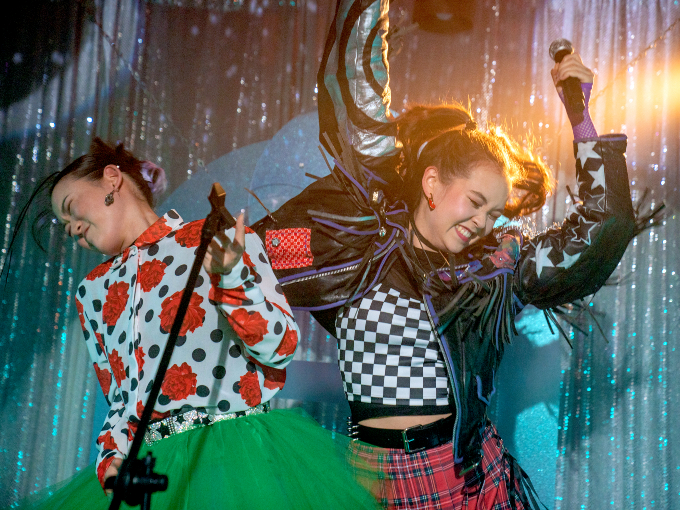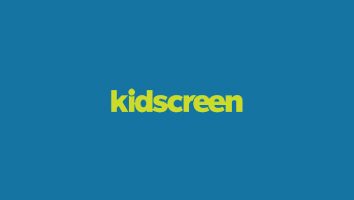The camera begins rolling. A group of young actors sequence through a sharp dance routine on a massive stage. Behind them is a long runway, glowing under dozens of neon purple lights. Both spacious and glamorous, it looks like a practical set to the cast and crew, but it’s all just an illusion—and not the green-screen kind. It’s a new cutting-edge technology, known as The Volume, that has been revolutionizing Hollywood productions in recent years.
Kidscreen recently spent an energetic day on the set of upcoming series Gangnam Project (working title), created by well-known kids producer Sarah Haasz. Her banner, Pillango Productions, co-produces the 10 x 30-minute series for kids ages eight to 14 with Aircraft Pictures in Toronto. Pillango developed the concept with CBC Kids (Canada), and CBBC (UK) came on board last year as a co-commissioner.
Gangnam Project is one of the first kids shows to use The Volume; actors film in front of a giant LED wall with a realistic, interactive background that moves in tandem with the camera. The virtual production process first came to prominence in 2019, when VFX company Industrial Light & Magic developed it for Disney+ series The Mandalorian. Since then, it has been used on an increasing number of productions, including Thor: Love and Thunder and The Batman.
Gangnam Project centers around Hannah, a Korean-Canadian teen who travels to South Korea to teach English and connect with her heritage. When she unexpectedly winds up in a K-pop school, she’s swept into a world she has so far only admired from afar.
The coming-of-age series has been in development for around six years. It started out as a story focused on a young girl who reflected Haasz’s experiences growing up as a first-generation Korean-born immigrant. “The challenge was finding a vessel that would pique the interest of the target age group,” she says. “And that’s how K-pop came into the story.”
Haasz is showrunning with Romeo Candido—the pair previously served as co-showrunners on teen drama The Next Step. As a Filipino-Canadian, he’s had similar experiences in navigating cultural identity, which Haasz says made him an ideal fit.
Korean music has been at the center of a global boom in recent years, and K-pop delivered eight of the top-10 best-selling albums worldwide last year (with dedicated teen fans driving the lion’s share of sales and streams), according to a 2023 report from the International Federation of the Phonographic Industry.
Bringing a K-pop school into the show’s storyline not only captures this cultural zeitgeist, it also provides a fun playground for writers to tap into all the elements of classic teen TV. “There’s friendship, family, dreams, aspirations, acceptance,” says Haasz. “And forbidden love, of course!,” adds Aircraft co-president Anthony Leo.
It’s a reference to the real-life rule that restricts K-pop trainees from dating—one of the many things Haasz learned in her extensive research of the industry, which included consulting a friend who was a former K-pop star and visiting actual K-pop schools in South Korea.
Mohawk College, in the Canadian city of Hamilton, served as the primary filming location for Gangnam Project. Its campus will be featured on screen as One Mile Entertainment, the K-pop school that Hannah attends. It’s an aspirational setting, where the choreography is as slick as the outfits are glam—satisfying the audience’s appetite for escapism, Leo says.
To go the extra mile, August Rigo (who has penned songs for Korean supergroup BTS) was recruited to compose the soundtrack. Casting was equally rigorous—criteria stipulated a half-Korean actor for the lead, and an ensemble of triple threats who could also sing and dance like K-pop idols, Haasz recalls.
Leo came up with the idea to use the Volume facility, with access provided in a partnership between Toronto-based Dark Slope Studios and The Immersion Room. He says the ability to film using the facility’s backgrounds and technology was a “game-changer,” as it not only helped achieve certain shots of Korea, but also elevated the ambitious music sequences to match the versatility of a real-life K-pop video.
“It became part of the process of writing the scripts, knowing that we had access to this tech,” says Leo.

Gangnam Project is one of the first kids shows to use The Volume facility, where actors film in front of a huge LED wall with realistic, interactive backgrounds.
The background looks just like a physical set on screen, but saves the time and effort of traveling or building sets from scratch. And the most surprising advantage is how much it helps actors when they can actually see what they’re engaging with, compared to performing against a green screen, says Haasz.
Marie McCann, senior director of children’s content at CBC Kids, says the series stands out with its fish-out-of-water premise—intertwining a deep story about immigrant identity with the fun setting of the K-pop world. “It’s completely on the pulse of pop culture and what kids are interested in,” she says.
For one thing, having a K-pop enthusiast as a protagonist is likely to score some major relatability points among young fans of the genre. But the series also o ers a strong dose of sincerity and optimism, which have been missing in this demo’s TV landscape, notes McCann. “We’re really trying to come up with shows that are an antidote to the much more mature and sometimes cynical shows that young tweens are watching.”
Filming in Canada (along with a few scenes shot in South Korea) wrapped in September. Gangnam Project is slated for a spring 2024 launch, with Federation Kids & Family handling global distribution.
This story originally appeared in Kidscreen‘s October/November 2023 magazine issue.



























